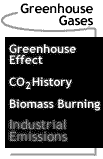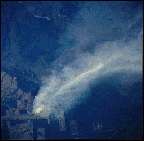

 |
Greenhouse Gases:
Industrial Emissions  Industrial emissions is a
broad term covering any process which involves fossil fuel combustion. This includes
industry, residential heating, transportation (cars, trucks, and airplanes), utilities,
and commercial heating. Fossil fuels include coal, oil, natural gas, and gasoline. Photo: Courtesy of EarthRISE. Industrial emissions is a
broad term covering any process which involves fossil fuel combustion. This includes
industry, residential heating, transportation (cars, trucks, and airplanes), utilities,
and commercial heating. Fossil fuels include coal, oil, natural gas, and gasoline. Photo: Courtesy of EarthRISE.Two other processes are also usually included with industrial emissions. The first is the production of cement, which releases large amounts of CO2 as the limestone is prepared. The second item is gas flaring from oil fields. Above an oil deposit, there is nearly always a natural gas pocket. These are usually burned off as the gas reaches the surface and are not stored for use. Fossil fuel burning can be thought of only as an input to the carbon cycle, since it takes millions of years for new fossil fuel reserves to be formed. Here is another way to think of this: It took millions of years to store the carbon in Earth's coal, oil and gas reserves, but humans will essentially deplete them in a span of 300 years. In the U.S., utilities account for 36% of CO2 emissions from fossil fuel burning. Transportation produces 31%, industry 22%, and the remaining 11% is residential and commercial heating. Emissions can be broken down by fossil fuel type. Petroleum products account for 44%, coal 36%, and natural gas 20% of CO2 emissions in the U.S. Worldwide emissions of CO2 from fossil fuel burning have stabilized in the 1990s at 6000 to 6200 million tons of carbon. This is dramatically higher than the 1638 million tons emitted in 1950, however. Worldwide emissions data can be found in the Fossil-fuel Burning activity, where the effect of fossil fuel burning on CO2 levels in the atmosphere is investigated.
[ Greenhouse Gases: Greenhouse Effects / [ Home ] [ Teacher Pages ] [ Modules & Activities ] |
HTML code by Chris Kreger
Maintained by ETE Team
Last updated November 10, 2004
Some images © 2004 www.clipart.com
Privacy Statement and Copyright © 1997-2004 by Wheeling Jesuit University/NASA-supported Classroom of the Future. All rights reserved.
Center for Educational Technologies, Circuit Board/Apple graphic logo, and COTF Classroom of the Future logo are registered trademarks of Wheeling Jesuit University.